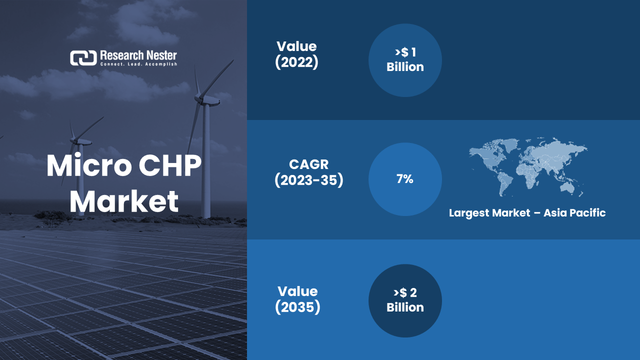Research Nester’s recent market research analysis on “Micro CHP Market: Global Demand Analysis & Opportunity Outlook 2035” delivers a detailed competitors analysis and a detailed overview of the global micro CHP market in terms of market segmentation by application, fuel, capacity prime mover, and by region.

Growing Concern for the Prevalence of Chronic Diseases to Promote Global Market Share of Micro CHP
The global micro CHP market is estimated to grow majorly on account of the increasing adoption of clean energy. Electricity production is primarily associated with a higher generation of greenhouse gases, which has severely impacted the environment over the years. Therefore, the need for clean energy is becoming imperative. Micro CHP plays an important part in the use of sustainable energy. These systems provide an effective and environmentally beneficial method of concurrently generating heat and power, lowering greenhouse gas emissions, and boosting energy efficiency.
Besides this, the rising infrastructural development has also contributed to the market growth. Micro CHP is increasingly being used in new buildings to suffice the growing demand for energy since it can meet the demand by supplying both power and heat. By 2060, cities around the world will have added around two trillion square feet of infrastructure. Furthermore, with the rise in the number of building the need for space heating is also rising exponentially which is another factor that is driving the market growth. Unlike traditional heating systems, which rely on intermittent fuel burning, micro CHP systems run continuously, ensuring a consistent heat output.
Some of the major growth factors and challenges that are associated with the growth of the global micro CHP market are:
Growth Drivers:
· Rising to Need to Produce Sustainable forms of Electricity
· Growing Urbanization and Industrialization
Challenges:
In comparison to other systems, such as conventional heating systems and offshore electricity generation, the installation cost of micro CHP is much higher, and people are not fully aware of the benefits of micro CHP in both residential and commercial sectors are some of the major factors anticipated to hamper the global market size of micro CHP. On the other hand, the market is micro CHP is highly fragmented and doesn’t have any fixed standardization, which is likely to stifle the market growth. The micro CHP market consists of various technologies and manufacturers, leading to market fragmentation and a lack of standardization. This can create challenges related to system compatibility, interoperability, and maintenance. Developing industry standards and certification programs can help address these challenges and ensure quality, reliability, and interoperability across different micro CHP systems.
Access our detailed report at:
https://www.researchnester.com/reports/micro-chp-market/5059
Based on the prime mover, the global micro CHP market is segmented into the fuel cell, IC engine, and Stirling engine. The fuel cell segment is to garner the highest revenue by the end of 2035 by growing at a significant CAGR over the forecast period. The need for reducing the GHG emission, and the need for fuel cells has significantly increased. Furthermore, on integrating it with micro CHP, reduces the overall negative impact on the ecology. Besides this, based on application, the market is further fragmented into residential and commercial. The residential segment is to grow significantly owing to higher demand for electricity and the deployment of distributed electricity grids. Moreover, by fuel, the micro CHP system running on natural gas & LPG is expected to dominate the market.
By region, Europe’s micro CHP market is to show notable growth and will generate a good share of market revenue. Europe is transitioning towards a more decentralized energy system, where energy is produced close to the point of consumption. Micro CHP systems fit well into this trend as they can be installed in residential, commercial, and industrial buildings, providing localized energy generation and reducing dependence on centralized power plants. This decentralized approach improves energy security, and grid resilience, and reduces transmission losses. Furthermore, policy frameworks such as the renewable energy directive and the energy performance of buildings directive have provided a regulatory framework for supporting the deployment of micro CHP systems
This report also provides the existing competitive scenario of some of the key players of the global micro CHP market which includes company profiling of YANMAR HOLDINGS Co., Ltd., General Electric, 2G Energy AG, SAMAD POWER LTD., Vaillant Group, Viessmann Manufacturing Company Inc., Axiom Energy Group, LLC., Micro Turbine Technology B.V., Alkaline Fuel Cell Power Corp., and BDR Thermea Group
Request Report Sample@
https://www.researchnester.com/sample-request-5059
Research Nester is a leading service provider for strategic market research and consulting. We aim to provide unbiased, unparalleled market insights and industry analysis to help industries, conglomerates, and executives to make wise decisions for their future marketing strategy, expansion, investment, etc. We believe every business can expand to its new horizon, provided the right guidance at the right time is available through strategic minds. Our out-of-the-box thinking helps our clients to make wise decisions to avoid future uncertainties.
Contact for more Info:
AJ Daniel
Email: [email protected]
U.S. Phone: +1 646 586 9123
U.K. Phone: +44 203 608 5919